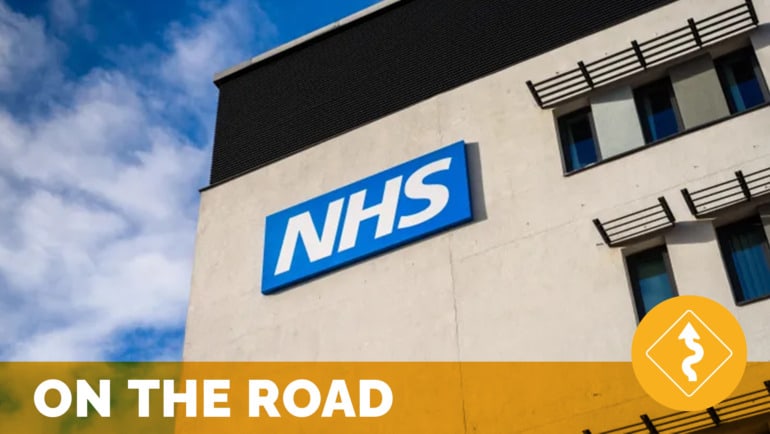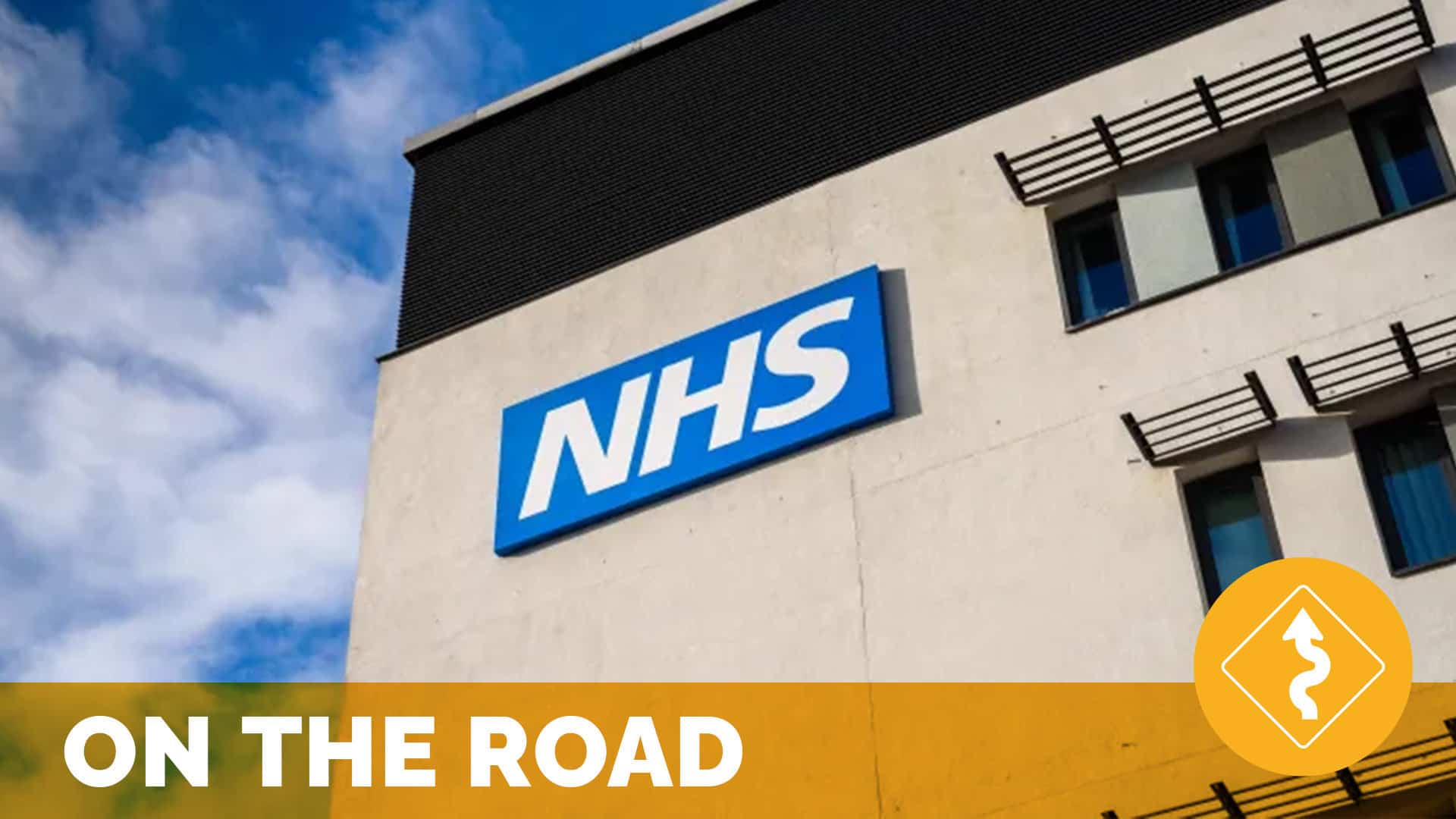A Global Look at Improving Patient Experience
Published September 1, 2011


On the Road with Inspiration NW, NHS North West Manchester, United Kingdom – September 2011
by Jason A. Wolf
Our September On the Road took me to Manchester, United Kingdom for a visit with Inspiration NW. This team of patient experience leaders is building a focused effort on the service experience in the National Health Service
(NHS) and primarily serve NHS North West, which includes:
- Five commissioning clusters (previously 24 Primary Care Trusts – For those of you in the US, a trust would be a healthcare facility or hospital.)
- Thirty-eight NHS hospital trusts, including: 23 acute trusts (i.e. providing accident and emergency services and general medical care)
- Eight mental health trusts
- Seven specialist trusts (i.e. providing specialist cancer services or children’s services)
- One ambulance service
I was impressed by the commitment this vibrant team of six healthcare leaders, including supporting consultants has to raise the conversation and focus on patient experience in Northern England. Their charge is simple, to lead the development of service experience in the North West, by supporting leadership, increasing capacity, and reinforcing quality. They also work in collaboration with the Department of Health, England to support delivery of the patient experience policy.
The team, led by Mandy Wearne, Director of Service Experience, has built a strong platform on which to expand the patient experience dialogue. The idea of Inspiration NW is to inspire a focus on unparalleled service in patient care across their service venues, from primary care, to hospitals to ambulance services. This is no small feat, but one in which Inspiration NW was inspiring indeed to experience.
A Foundation for Action
The core focus in helping drive patient experience outcomes is grounded in a critical perspective, that patient experience is closely related to and influences clinical effectiveness and safety. Three core premises support this idea:
Patient-centred organizations have better clinical outcomes.
Doctor-patient communication leads to greater compliance in taking medication and self-management for people with long-term chronic conditions.
Patient anxiety and fear can delay healing.
By drawing the connection of patient experience to the overall quality effort including both effectiveness and safety, the team at Inspiration NW elevated the conversation on patient experience. They based this work off the five Domains in the NHS Outcomes framework, where you can see the important linkage of effectiveness and safety with a clearly stated focus on positive patient experience.
“The key to an effective effort,” said Janet Butterworth, Associate Director of Service Experience, “is to help people understand the connected nature of these critical aspects of healthcare. We gain support in our focus on patient experience by helping people see this is not a separate, but rather an integrated part of the overall care equation.” This is a powerful recognition and shared characteristic that I continue to observe in high performers addressing patient experience; that you cannot address experience in isolation, as a distinct project or separate initiative. Rather it must be an integrated part of a plan of improvement and excellence in overall experience before, during and after clinical care.
Key Points of Focus
With the broad scope on which the Inspiration NW team could focus, they worked hard to identify areas in which they could have greatest impact. In doing so they also recognized the importance of clarity in framing the service experience. Mandy Wearne stressed, “It is important to recognize that service experience has two dimensions; the first, what happens to the patient, and the second, how they feel about the experience.” This reinforces the point that experience does not happen in isolation.
In addition, Wearne added, “The evidence suggests that people want to feel better about their overall experience including not only the outcome they were seeking, but also how they feel about the service they received.” Again we see the importance of an integrated approach.
To clarify its direction and create a picture of good experience, the team worked with consulting firm PriceWaterhouseCoopers LLP, to create a framework for Service Experience which takes account of the following experiences of care:
- What happens to the patient
- Service Delivery (Access, waiting times, consultation time, out of hours provision, confidentiality, outcomes of consultations)
- Staff (expertise, accessibility, interpersonal skills and multidisciplinary working)
- Communication (patient involvement in decision making, information provision, understanding of patient needs, use of alternative means of communication)
- How the patient feels about the experience
- Focusing on the emotional aspects of care and what matters most to each individual patient, a set of eight emotional needs are used to support staff and patients to foster meaningful conversation which can be used to influence care in real time.
I believe this is a powerful statement as the team from Inspiration NW exemplified what it truly means to advocate for the patient experience. By understanding, recognizing and acting on patients needs directly, there is the greatest opportunity for impact. It also causes me to ask what have we done in hospitals (not just in the US, but around the world) to identify as this group did, the emotional needs of our patients? And what have we done to act on them? Based on these needs, the concept of Care Cards was developed.
Care Cards: Connecting with the Emotional and Service Needs of our Patients
Care Cards emerged as a tool to address the care experience by involving the patient directly. These eight simple, yet powerful, cards based on the emotional needs outlined above became a tool for directly fostering conversation between a caregiver and patient. The caregiver spends a few minutes with a patient discussing the cards and then asks the patient to prioritize them based on their personal needs. In addition to fostering conversation and establishing a relationship, the process helps recognize needs and allows the caregiver to customize the experience provided.
While still in pilot phase, this process has had significant impact on experience. First, in a cohort of 500 patient, 83% of the situations where care cards were used care was improved. This is important as it shows that by understanding patient needs we have a better opportunity to ensure a personal experience for a patient – aligned not only with experience, but outcomes.
Second, 96% of patients found cards helpful in expressing preferences. It brings the patient voice back into the care equation and helps them feel they have a role in influencing their own experience. As Pam Sambrook, Programme Support for Inspiration NW offered, “This process truly gives power back to the patient.”
Lastly, an important message emerged as significantly wide variances of preferences were cited amongst patients. The cards reinforce that we must be aware that every patient has a unique perspective, personal priorities and specific needs. With the ranking of cards showing up in multiple variations, it reinforces that we must be aware that every patient has a unique perspective, personal priorities and specific needs. All too often in healthcare we opt for a one size fits all process because it best suits how we want to operate our facilities, yet this mind set overlooks the individuality of each patient. The preliminary Care Card results help us realize that to truly succeed in addressing the patient experience we cannot rely on simple repetitive processes. This does not mean standardized processes such as rounding and scripting have no purpose, but rather they should be a component of a more personalized approach to meet the needs of each patient. Common process makes great sense in dealing with the clinical intricacies of care; however, they can actually diminish our achievements when we focus on true service excellence and positive experience.
The use of Care Cards as a tool proves there is great value in the real time connection of patient and caregiver. It links the operational and the emotional components in the care setting. It also shows the ability to reignite the passion in caregivers as they return to the bedside and engage their patients in powerfully personal ways.
Involvement and Patient Opinion at 5 Boroughs Partnership
I also had the chance to spend some time with Nick Rowe – Deputy Chief Executive, Dave Thompson – Assistant Director of Inclusion & Partnerships and a number staff members, patients (service users) and carers (care givers) in the 5 Boroughs Partnership, a Mental Health Trust just outside of Manchester to see how they have found new and innovative ways to positively impact patient experience. The team greeted me in mass for an overview of the amazing efforts taking place from Senior Leadership to the trust floors. While I could write an article alone on the activities at 5 Boroughs, I want to focus on a few key efforts that can translate globally and challenge our thinking on how we engage patients and the community in our patient experience efforts.
My visit could be summed up by the very people brought together who shared their stories. Not only were they leadership and program directors, they were also doctors, patients and active community members. Nowhere else during my On the Road visits did a facility bring the outside in for our visit. I mention this not as a criticism of others, but as an acknowledgement that this very action represented the essence of 5 Boroughs. As I heard from staff, patients and community members I witnessed what a truly systemic focus on patient experience could be, where leaders are available and transparent to the communities they serve, where patients engage in helping a facility review and uncover areas for improvement, where the community participates in ensuring the facility provides what it expects and needs.
Take it to the Top
The first example is “Take it to the Top,” a program through which Senior Leaders from the Trust (the Chief Executive and his team) go out into the community to hold meetings and take questions from patients and community members. This engagement of the community allows the leaders to understand the issues and opportunities for the trust by directly hearing from the consumers of their “product.” They answer questions raised and commit to getting answers from the appropriate people if they are not in the room. Based on questions asked in meetings to which he did not have the direct answer, he would invite the appropriate leaders to join him at the next meeting. This was not an option, but an expectation, as the leaders of the trust were exposed to the needs of the community around them.
What stood out in learning about this program was how the patients described the event. A Chief Executive would opening himself up for a potential barrage of the unknown in order to bring his facility closer to the needs of the community is a significant action and as one person stated, “a particularly brave undertaking”. This modeling of expected behavior is one of the best examples I have seen in healthcare of a willingness to step out and engage in a conversation of patient and community needs. By providing people direct access to the top and ensuring honest and straightforward answers, the leaders make a statement about how all staff should behave in engaging with patients, families and the community.
Big Brother Booth
Many hospitals are attempting to capture patient stories and video, but I have yet to see the creativity exhibited through the 5 Boroughs “Big Brother Booth”. Mirroring the British reality TV show then reproduced in the United States, the booth is portable and can be posted at various locations where people provide feedback, share stories and other information in a fun and informative way. Videos are collected around patient experience or other topics, edited and shared (Is it possible to link to any of the videos?). The program is not only fun, but allows the trust to show its commitment to engaging the voice of patients and the community.
Some positive impacts of the Big Brother Booth include:
- The ability to acquire feedback in real time
- The discovery of a board range of service improvements
- The impact on staff when reviewing footage of patient stories
- The idea has not only become a great means for the collection of information and the education of staff, but has also supported 5 Boroughs as it builds a continuous process of community outreach and engagement.
- This engagement has been a key to one of the most significant programs I have seen put in place around service experience, the 5 Boroughs Involvement Scheme.
Involvement Scheme
I close with the idea of the Involvement Scheme because of the profound impression it left on me and the impact it is having on the trust overall. In learning about this effort I heard from both program managers and patients about how they are applying this practice in a number of ways. While fundamentally a means for engaging patients and the community, it has become a strong resource in impacting overall service experience.
The Involvement Scheme, engages patients (service users) and carers (care givers) in the design, development and delivery of services. It covers all aspects of the business from individuals being involved in their care plans, to service users and carers sitting on the Trust Board itself. It invites them to join committees and working groups, be part of recruitment and training processes and even participate in investigations and audits. Not only does it invite participation, but the process provides full training and even some compensation and coverage of out of pocket expense.
The power of the Involvement Scheme is its ability to broaden the perspective of the trust itself. One example was the group work on infection control. Those involved provided new insight, participated in audits, and helped build go forward plans. As one patient offered, “we were able to participate as and were considered equals”. The value of this program was significant to the organizational leaders as well. In fact the infection control team was able to achieve major improvements. The team was recognized within the NHS and was asked to come to London to present their results as nominees for a Nursing Times award. Both leaders and volunteers were on stage and contributed to the presentation. They wowed the audience and won the award with great kudos to the volunteers. Even more impressive than the award itself was the pride with which the volunteers shared the story, talked about the confidence it gave them to contribute and the value they felt in being part of the process.
Another example of engaging volunteers in initiatives was the Stigma Campaign, which focused on changing the way that people engage in discussions on mental health and the words we use that create stigmas around the issue. Volunteers worked to actively involve community leaders, businesses, celebrities and others in ensuring awareness and support for the program, they even pitched me.
Another effort conducted audits of floors and units in the trust to observe things such as people consistently wearing badges, placement of/access to chairs, and issues of cleanliness or noise. What a great idea! While we have talked about patient and family advisory councils being an integral part of the service experience, to actively involving patients, families and the community in addressing issues of importance is a bold new step. Some even suggested it was risky to start, much like “Take it to the Top”, but it seems for 5 Boroughs the risk turned to reward. In fact, I was informed that though payment is offered for volunteers in the program, almost half of all individuals pass on compensation of any sort. They participate because they are committed and care, because they were invited, and want to create a great patient encounter and service experience for all in the trust.
While the commitment of the staff was palpable, the passion expressed by the volunteers was moving. With an expertise in organization culture, particularly in healthcare, I can usually sense a strong cultural foundation in an organization. This is not about signs or what a healthcare organization says it is, but rather it about what they do and how they do it. You could feel the energy and powerful sense of culture at 5 Boroughs.
The group also shared a significant emerging vernacular on how they are starting to frame participants in the involvement scheme. There are those that work in the organization, the staff and those that have been cared for, patients (service-users in the UK) and their families. But rather than using the common language they have dubbed staff EBOs (Experts by Occupation), that is those who were trained and/or work professionally in a role. The patients/volunteers are referred to as EBEs (or Experts by Experience), since they gained their knowledge through personal experience. This reveals the essence of the involvement scheme, the 5 Boroughs Partnership and the people who so graciously shared their stories with me. Whether an EBO or an EBE they were all experts, committed to the best experience possible for all those in the trust. And while they are quick to say they are still learning, it is clear that 5 Boroughs Partnership exemplifies what creativity and commitment can bring to improving the patient experience.
Wins and Lessons
As exemplified in the spirit of involvement at 5 Boroughs Partnership and through such practices as Care Cards, the efforts of Inspiration NW and the trusts across NHS North West are having significant impact. Some of the key wins shared by Inspiration NW that I believe we can all learn from include:
Involving patients in their care decisions – Patients are more prudent with treatment choices when properly informed.
Supporting effective transitions of care – Transitions often represent the biggest concern for patients. They also tend to be where waste occurs, are potentially unsafe and often lack in the innovation needed for highest quality care.
Creating happy staff to ensure happy patients – In converting staff from detractors to promoters of experience and service, they become advocates and the first line of service success.
The emotional support we can provide in these encounters may be one of the least expensive ways to address improvement.These clear achievements are significant in their simplicity, as the Inspiration NW team has prided itself on its ability to make change, not just implement programs. By encouraging patient involvement, by consciously linking effectiveness, safety and experience and by developing the right behaviors in staff to drive patient experience outcomes the team has had an important impact across the continuum of care. And, as they shared, their efforts have only just begun.
The team also identified some important lessons learned improving the patient experience. They include:
Be careful not to confuse service experience with patient engagement
Recognize that service experience is about relationships, not complaints
Beware of thinking that measurement or scorecards alone make a difference
A specific metric, gadget or tool will not serve as a single lever to success
Saying experience matters but rewarding other areas of performance could impede progress
Improvement is not just about process, it is about changing behaviors
We can never forget it is the patient/caregiver interactions that really matter (or should I say EBEs and EBOs)
A Need for Continued Global Dialogue
I have been extremely fortunate over the last year, our first year of On the Road, to engage with and encounter not only committed healthcare leaders, but truly generous professionals. I have had the privilege to visit community hospitals and large networks, provincial systems and national programs. In all I have found a commonality, that somewhere in all of our efforts in healthcare is the passion that drew so many of us to this work, providing the best experience for patients, supporting their families and positively impacting the communities we serve.
My visit with Inspiration NW exemplified this fully as I encountered a team driven by what they believe, I should say know, is right to do in healthcare. Their innovation and new ideas helped reinforce what I have always believed. That patients are patients in every corner of our globe and while systems may be different, functional, yet dysfunctional in their own special way, we have an incredible opportunity to learn from one another, share ideas and continue our efforts to improve the patient experience overall. My hope is that more of us are willing to look beyond borders not as a criticism to the differences, but to the powers of similarity and to the true wealth of learning that is available to us all.
At the Institute we clearly state our commitment to being a global community of practice on this critical issue. We look forward to engaging broader dialogues and catalyzing global sharing that will ensure we all are at the edge of what is best in providing top care and unparalleled service. The team at Inspiration NW is a perfect example of what we all can learn. My special thanks to my gracious hosts at Inspiration NW – Mandy, Janet, Nina, Pam, Stephen and Rachel – and to Dave and his team at 5 Boroughs Partnership all of my appreciation. I encourage more of you to join us on this important journey and share your stories.
Related content
-
Culture & Leadership | Infrastructure & Governance
Developing Multidisciplinary Committees for Patient Experience Effectiveness
Published June 26, 2025

This webinar explores how to move beyond recognizing the value of patient experience to embedding patient- and family-centered care into organizational culture. Learn how Patient Experience Committees, including a successful Cleanliness Committee, have driven improvements in HCAHPS scores, engagement, and collaboration. Discover strategies for structuring a Patient Experience Steering Committee with multidisciplinary subcommittees aligned to
Learn more -
Culture & Leadership | Infrastructure & Governance | Quality & Clinical Excellence
Health Equity: The Metronome for Human Centered Care
Published December 17, 2024

Complimentary – As the healthcare landscape continues to evolve, and as consumers seek a more personalized care experience, integrating health equity into experience management emerges as a critical factor in enhancing institutional performance. Traditionally, health equity has been viewed as a separate component of healthcare quality improvement. However, in this webinar, we will explore the
Learn more -
Infrastructure & Governance
Part of the team: Effecting change and sharing power in healthcare settings
Published April 27, 2023

In 2019, we, as a group of patients and researchers, were invited to rethink how the executive board received and responded to patient stories at a specific NHS hospital trust in the UK. Through an iterative series of meetings, we were able to co-identify common concerns and together develop a distinctive narrative framework for effecting
Learn more
